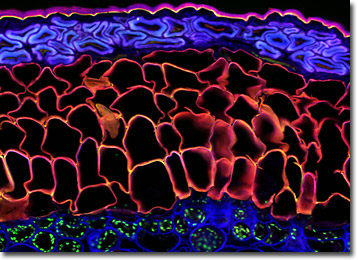 |
 |
 |
|
||||||||||||||||||||||||
 | ||||||||||||||||||||||||
 | ||||||||||||||||||||||||
 | ||||||||||||||||||||||||
Confocal Microscopy Image Gallery
Plant Tissue Autofluorescence Gallery
Ginkgo Stem
As the only living member of a primitive order of gymnosperms (Ginkgoales), the ginkgo tree is a stalwart survivalist. The tree is native to China and is scientifically described as Ginkgo biloba. Fossilized leaves of ginkgo relatives have been found distributed widely around the world and some date back more than 200 million years ago.

The reason that the ginkgo has outlived its relations is not known for certain, but it is thought that populations of the gymnosperms declined greatly around 60 million years ago and China became the final habitat of the ginkgo. Millions of years later, the appearance of humans may have helped the ginkgo endure, since the trees have been planted in Chinese temple gardens since antiquity. Today the ginkgo is planted in a wider variety of locations as an ornamental tree and is able to thrive even in polluted urban areas.
The ginkgo is a tall, pyramidal tree with gray bark, pale wood, and fan-shaped leaves. When the tree is mature, its branching is usually erratic, but the lateral branching of younger trees is often regular. The ginkgo is deciduous and the normally soft green leaves change colors in the autumn before they fall off in some locales. The tree is also dioecious, with the male trees being more commonly planted because the fleshy fruit of the female ginkgo is generally considered to have an offensive odor. The shelled seeds of the ginkgo are edible and are traditionally consumed in China. The seeds are considered to have health benefits by some, but more commonly today extracts from the leaves of the ginkgo are included in various health supplements that are purported to improve concentration, memory, and metabolism.
Additional Confocal Images of Ginkgo Stem
Ginkgo Stem at Low Magnification - The ginkgo’s amazing capacity for survival is exemplified by a small number of the trees that successfully endured the atomic bombing of Hiroshima, Japan in 1945 though they were situated just one to two kilometers from the epicenter of the massive blast.
Contributing Authors
Nathan S. Claxton, Shannon H. Neaves, and Michael W. Davidson - National High Magnetic Field Laboratory, 1800 East Paul Dirac Dr., The Florida State University, Tallahassee, Florida, 32310.
